11
Neoclassicism in Painting and Sculpture
Neoclassicism was the first artistic movement since International Gothic to become fashionable and to develop almost simultaneously in a European and not in a national context. Unlike the classicism of the High Renaissance and of the early seventeenth century, with their concentration on the city of Rome which gave to those styles an identifiable homogeneity, Neoclassicism derived from its international currency a variety of subjects, styles and attitudes which make any simple definition an impossibility.
The Grand Tour
However, Rome was again the setting for the first productions of the movement.649-652 This was due partly to the examples of earlier classicism assembled there, and partly to the antiquities which, as E. Q. Visconti wrote proudly, made Rome 'the sole treasure-house of beauty, and the temple of good taste . . . The nations crowd around the universal Mother of solid doctrines and fine arts . . .'. During the eighteenth century, a tradition grew up in Britain that no education was complete without an extended tour of the sources of Western civilization; Rome was the main city of interest, since Greece was still under the control of the Turks and remained little visited.648'650 Schoolmaster guides would expound the acknowledged masterpieces of antique and modern art in front of the works themselves. Those rich enough would buy and bring home antiquities and works of art, and install them in suitably antique country houses. Copies and forgeries found a ready sale, as did prints and lavishly illustrated books of the antiquities of the City. In a word, the mania for the classical
tradition was planted for the first time in England.651 There had been precursors, such as Inigo Jones, or the Earl of Arundel who made a famous collection of antique marbles, but now antiquities were imported almost wholesale into the richest country in Europe. Curiously, the Germans and other northern states did not join in the plundering until the end of the century. France, fortified perhaps by memories of her own seventeenth-century classicism, stood aloof. Certainly, the British had much ground to make up. They founded the Royal Academy in 1768 on the model of the French Academy of Painting—but then surpassed the French in the richness of two more scholarly institutions, the Society of Antiquaries (founded 1707) and the Society of Dilettanti (1732). Both societies were responsible for the encouragement of exact scholarship which is a feature of Neoclassicism. The Dilettanti, whose rules stipulated that only men who had trodden 'Classic Ground' were to be admitted, sponsored expeditions to Asia Minor and Greece. The Antiquaries, on the other hand, were just as concerned with the Middle Ages as with classical Antiquity.
Scholarship and Neoclassicism
The Grand Tourists were well served by the greatly increased rate of archaeological excavation, and the wealth of published documentation on the life and art of the Ancients which resulted from it. The famous excavations at Pompeii655'656 and Herculaneum,659'661 begun in earnest in the 1730s, attracted many visitors. Many finds were stolen, in spite of jealous security measures which forbade even

Bartolommeo Cavaceppi: A view of his studio, from his Raccolta d'antiche statue, I, Rome, 1768. He was the greatest 'restorer' of antique statues.
sketching. During the later eighteenth century, much excavation took place in Rome and its environs, and the objects discovered were used to ornament Roman and foreign collections.657'658 This is not the place for a disquisition on the early history of archaeology (a subject which awaits full treatment),653 but it must be understood that archaeologists and historians of art in the eighteenth century were all concerned with uncovering and publicizing antiquities which, it was hoped, would lead toward a revival of the 'true style'—which we know as Neoclassic-ism. Of course, neither discipline was formulated on a scientific basis in that century, but a feature of Neoclassicism was the contemporary interest in archaeological and historical exactitude.
198
Indeed, the excavations of the eighteenth century, and the objects uncovered, were both cause and symptom of a more highly developed historical consciousness than had previously been seen.654 Books of illustrations of antiquities had been available since the Renaissance, but now for the first time scholars began to make encyclopedic compilations of knowledge of the Ancients. The first compilations of this kind, J. G. Graevius's Thesaurus antiquitatum romanorum (12 vols, 1694—9) and J. Gronovius's Thesaurus antiquitatum graecorum (13 vols, 1697-1702), are collections of earlier works, occasionally illustrated. But the Abbe de Montfaucon's L'Antiquite expliquee et representee en figures (10 vols, Paris, 1719-24) is different in that it is built around the numerous plates and, instead of being in Latin only, has parallel texts in Latin and French. An English edition later appeared (1721-5), and then a German edition. This gigantic picture-book with commentary remained an essential work of reference throughout the century, rivalled only by the catalogue of the collection of antiquities of a younger compatriot, the Comte de Caylus's RecueiI d'antiquites ... (7 vols, Paris, 1752-67), which is a great step forward in two respects. First, the antiquities described were those of the Greeks, the Egyptians, the Celts and the Etruscans as well as of the Romans. Second, Caylus attempted to attribute items, and to arrange them chronologically, in terms of their style and not, as all previous scholars had done, of their usage. This interest in style implies a recognition of its importance in
The museum in Sir John Soane's house in Lincoln's Inn Fields, London. Soane's collection, formed in the late eighteenth century, displays both a neoclassical concern with detail and a catholicity of interest. From The Union of Architecture, Sculpture and Painting, London 1827.
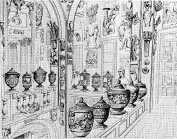
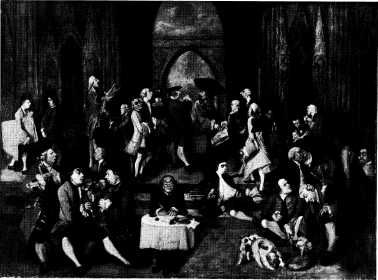
Joshua Reynolds: Parody of Raphael's School of Athens, 1751. Dublin, National Gallery of Ireland. Note the Gothic setting, which indicates that the traditions of England are radically different from those of Italy.
establishing a chronology of ancient art, which Winckelmann was to take one step further in his History of Art of 1764. Contacts between scholars like Winckelmann and Caylus and practising artists were as close in the age of Neoclassicism as they had traditionally been in earlier periods of classicism. Caylus himself holds an important place in the encouragement and development of a classical style in France; Winckelmann was involved with the art of Mengs, Gavin Hamilton with Canova, and Quatremere de Quincy with David.660
The net result of such excavation and publication was a widening of permissible sources which might be imitated and, thanks to the awakening of historical consciousness mentioned above, a more developed critical sense in dealing with them. The patently inferior quality of much of the work found at Hercu-laneum and Pompeii, especially the paintings, caused some disappointment. However, manystudents were convinced from their reading of the ancient authorities that the superiority of the ancients in sculpture was by no means matched in painting. The Quarrel of the Ancients and Moderns, still full of life, as the argument between Diderot and Falconet shows, proclaimed that in painting the modern world had surpassed Antiquity.662 In sculpture, however, nothing emerged from eighteenth-century excavations to match those sculptures and bas-reliefs which had been known and admired since the Renaissance. A disturbing factor in Winckelmann's appraisal of Greek art is that most of his examples had been known for centuries (see pp. 202ff., below).
As early styles were brought to prominence by scholars, the focus of artistic and literary subject-matter and style began to move backwards in time. The Roman Republic gained
199
more attention than the Empire, and the Greece of Homer took precedence over the Rome of Virgil.672 Philosophers dwelt on the corruptness of modern society in comparison with the simple and natural life of the primitive peoples of the world, and with Western Europe's own predecessors in that golden age of heroes described in the ancient epics.667 A state of 'nature' was equated with virtue; the nearer to that state a society might be, so it was the more worthy of emulation on account of its virtue. Homer, the earliest known epic writer, was a focus for such primitivism, as can be seen in Robert Wood's Essay on the original genius of Homer (London, 1769). When he compares the age of Aristotle with that of Homer, his comparison is qualitative: 'I will venture to say that they differed as much, with regard to their reigning virtues and vices, their state of police and degree of civilization, their modes and tastes, in short, the great business and leading pleasures of life, as we do in these respects, from our Gothic ancestors in the days of Chivalry and Romance . . / (Preface). The earlier state of society is to be preferred. The parallel between early Greece and the days of Chivalry is important for neoclassical art, which was to devote much attention to the heroic Middle Ages and also began to appreciate styles before Raphael.671 Again, the scholars preceded the artists in that field as well. The eighteenth century witnessed the beginnings of serious documentary study of the Middle Ages as well as of Antiquity. Important work was done on manuscripts and on medieval history, particularly in England and Germany. It appeared quite natural to neoclassical artists that they should apply the same kind of style to their treatments of the Middle Ages as to their works on antique themes.
In part, a concern with history sprang from nationalism, which gave as much of a spur to Piranesi's championship of Italy as the home of good architecture as it did to Tuscany's newfound pride in its early past. An English scholar, Thomas Dempster, first aroused scholarly interest in the culture of the Etruscans in the seventeenth century with his De Etruria regali. The manuscript was not published until
200
1723—4, and it prompted a whole series of publications that included information on Etruria. As a weapon to fight off the burgeoning admiration for the Greeks, Piranesi found what he conceived to be the Etruscan achievement most useful. In Tuscany itself, the glorious past—the ancient, not the Renaissance past— was the reason for the foundation of the Accademia Etrusca in Cortona in 1726.663'664
The international nature of Neoclassicism combined with nationalism to assure the success of an outright forger. James Macpherson's poems of 1761-3, purporting to be the rediscovered and translated work of the blind Gaelic bard Ossian, provided Northern European writers and artists with a corpus of heroic deeds comparable to the best loved passages of Homer.666'668 The poems of Ossian were early proclaimed as a forgery, but occasioned an enthusiastic response from a group of countries who began to feel a pride in the past.665'670 They provided a fund of biblical language and simple morality. Stronger instances of nationalistic feeling can also be seen in the German interest in Teutonic legend, the English vogue for Shakespeare (who also became popular in Europe), and the numerous instances of the celebration of the national past in art. The idea of Rome had, from Carolingian times onward, been instrumental in the forging of state or dynastic identity. This impulse, in its turn, usually drew on the classical tradition for its motifs and style. But now a truly historical interest in national identity was to drive Rome and classicism slowly but surely into a position of minor importance, until the most recent revivals. Mussolini, with his logically classical revival, looked back to the grandeur of the Roman Empire. The Third Reich, on the contrary, brewed up a crazy mixture of classicism and German folk-art.
Neoclassicism and morality
Yet if subject-matter itself is no solid guide to Neoclassicism, the particular emphases in that subject-matter, and their stylistic treatment, provide a ready way of distinguishing Neoclassicism from the Rococo manner which preceded it. Neoclassicism, like all art in the classical tradition, required work capable of a moral and rational interpretation. On both these grounds, Rococo was therefore distasteful. For a neoclassical artist, his style must eschew the prettiness and lushness of Rococo, and discover a style which would reflect the rugged morality of the subject in the sparse simplicity of setting, figures and painting technique. Some neoclassical theorists pursued an even closer connection between art and morality. Believing that art could be a positive aid toward morality, they suggested historical subjects which could underline moral criteria. The Roman historians and moralists, particularly Plutarch, were rich in episodes which would provide a stern alternative to the immoral or amoral productions of the Rococo. Such a belief in painting as an expression of the philosophy of life, an exemplum virtutis,669 was not new. In France, it had been a central tenet of Poussin's art. In an age of such varied subject-matter from so many periods of history, we may perhaps consider as neoclassical that which is treated in a heroic and moralistic manner, and in a style which bears the traditional classical qualities of balance and restraint.
Gavin Hamilton: an early neoclassicist
Most of the features discussed so far in this chapter are to be found in the life and work of Gavin Hamilton, a Scotsman who lived in Rome from 1748 until his death in 1806. In the

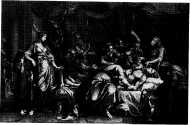
John Flaxman: Thetis bringing the armour to Achilles. Engraving by Piroli, The Iliad, London, 1805.
Gavin Hamilton: Andromache Mourning the Death of Hector. Engraving by D. Cunego, 1764. The work looks back to Poussin's Death of Germanicus and antique sources.
development of Neoclassicism he is a key figure as an archaeologist, as a dealer in antiquities, as a disseminator of ideas about art and as a painter. He was, for example, friendly with those pillars of the Graeco-antiquarian style in architecture, Stuart and Revett. He visited the sites of Italy with them, especially Pompeii and Herculaneum, and may well have urged them to go to Athens. He advised Canova, who had settled in Rome in 1780, on the direction his style should take, and was perhaps instrumental in turning him away from the Baroque and toward the classical. The confines of his own taste are apparent in his Schola Italica Picturae (1773), where forty sixteenth- and seventeenth-century Italian paintings are reproduced, from Raphael and Michelangelo to the Carracci, Guido Reni and Caravaggio. In his first year in Rome, he was writing enthusiastically of the work of Dom-enichino, and his own painting is evidently based as much on seventeenth-century art as it is on classical antiquities.673
A fine publicist, Hamilton's work became known through engravings which, in the early 1760s, provided Europe with early illustrations of Homeric subjects treated in a stern and moral manner. For example, his Andromache Mourning the Death of Hector (engraved 1764) is built up of ranks of figures strictly parallel to the picture plane. The figures, eloquent in their restraint and noble in their form (in some cases derived directly from antique statues), gather round the bed in the
201

Mengs: Parnassus, 1760-1, fresco. Rome, Villa Albani.
manner of a conclamatio sarcophagus. The subject might be Greek, but any painter at the end of the century would have found the scene far too crowded and even ornate. Evidently, the source of its style is not Greece but the classicism of the seventeenth century, particularly the death-bed scenes by Nicolas Poussin. The same features are apparent in Hamilton's other works.675 It is an interesting sidelight on Neoclassicism that a man who had so much opportunity for examining newly found Greek and Roman antiquities began to develop his own art as part of the existing classical tradition, and tried in no way to break away from it.674 He can be contrasted with later artists, such as Flaxman, who, ignoring the Renaissance and seventeenth-century achievements, sought a style which really did attempt a tabula rasa.
Winckelmann and Mengs: the scholar and the artist
Hamilton's ideas on the imitation of past art were similar to those of Anton Raffael Mengs, except that Mengs's paintings have rather more Rococo prettiness about them.680 His father named him after Correggio and Raphael,
202
and encouraged him to copy the Vatican stanze of his namesake. Like Reynolds, he derived his income and popularity mainly from his accomplished portraits, but his heart was with grand historical painting. His Gedanken uber die Schonheit of 1762, quickly translated into Italian and Spanish in 1780, French in 1781 and English in 1782, proclaimed his ideal style as a mixture of Raphael, Correggio and Titian, plus a close study of Greek sculpture. In this eclectic view,682 expression was taken from Raphael, grace and chiaroscuro from Correggio, colouring from Titian, and the ideal of beauty from Greek Antiquity—this last being the key to the formula, and the only particular in which it differed from the supposed formulae of the Carracci or the younger Poussin. An example in paint of this formula was Mengs's Parnassus of 1760/61, a fresco decorating the centre of the ceiling of the Salon in the Villa Albani, which was the room used by Cardinal Albani to display part of his famous collection of antique sculpture. The composition is a reworking of Raphael's Parnassus, with the Apollo Belvedere, the Borghese Dancers, and a pensive figure from the Aldobran-dini Wedding prominent within the carefully balanced composition. It is not an impressive painting, for it lacks the vigour of its sources.
But it has all the hallmarks of a demonstration piece, and therein lies its importance; its success amongst the cognoscenti indicated the reaffirmation of classicizing ideals in Rome. Its similarities to the Farnese Gallery would not have been lost upon its admirers. The remainder of Mengs's work in the historical manner echoes his respect for Raphael and the Carracci.
Winckelmann thought Mengs the greatest of modern painters. The artist had arrived in Rome from Dresden in 1752, having already spent 1741^1 and 1747-9 in Rome. When Winckelmann himself came from Dresden in 1755 to be librarian to Cardinal Archinto, he was helped by letters of introduction to the painter, whose star was already in the ascendant. When Archinto died, Cardinal Albani made Winckelmann his librarian, thereby giving him the opportunity to study antique art and its literature in the midst of one of the best private collections in Europe. Winckelmann's post also entailed the curatorship of that collection, and he no doubt supervised if he did not programme the extensions to the Villa Albani (c. 1760) and its decoration. Dresden, with its great library, its Correggios and its Sistine Madonna, had helped to form Winckelmann's taste; in Rome he began to apply his ideas to building a formidable reputation as an antiquarian and historian.681 He wrote essays on the Torso Belvedere and Apollo Belvedere (1759), on frescoes at Herculaneum (1762 and 1764—the first discussions), and a History of Ancient Art (1764), the fruit of seven years' work. The previous year he had been made Commissioner of Antiquities at the Vatican, a post similar to that held by Raphael himself. He detested the Baroque,683 and found even the Seicento classicists insipid in comparison with Mengs, whose Parnassus he considered far superior to Reni's Aurora. Even Domenichino, who 'studied the ancients more than any other follower of the Carracci. . . did not achieve the purity of Raphael in drawing the nude . . .' For Raphael is his hero,677 and his opinions on Greek art679 coincide so closely with his opinion of Raphael that he clearly saw him as a Greek reincarnate; he writes in the Gedanken:
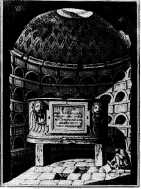
P. d'Hancarville: Imaginary tomb of Winckelmann. Frontispiece to Antiquities from the Cabinet of Sir W. Hamilton, Florence, 180Iff. The tomb was to honour the man who set the fashion for collectors like Towneley and Hamilton.
Noble simplicity and sedate grandeur are ... the true characteristical marks of the best and maturest Greek writings, of the epoch and school of Socrates. Possessed of these qualities Raphael became eminently great, and he owed them to the ancients. That great soul of his, lodged in a beauteous body, was requisite for the first discovery of the true character of the ancients; he first felt all their beauties. Ye that approach his works, teach your eyes to be sensible to those beauties, refine your taste by the true antique . . . Elsewhere he calls Raphael 'this god of artists', and states that 'we know he sent young artists to Greece, to copy there, for his use, the remains of antiquity'.
Winckelmann's belief that Greek art was the stimulus for the High Renaissance is anachronistic, and reveals much wishful thinking. It may be that he induces his specifications for good art from Raphael and applies them to his study of Greece, and not vice versa. What is crucial in Winckelmann's assessment of Greek art is the place he allots to it in the pattern of civilization. He explains in his History that
203
Greek art was so fine because it was influenced by the climate, the politics and the thought of the Greeks, and that their love of physical beauty, based on the male nude, was connected with their simple life-style and their love of liberty: 'it was liberty, mother of great events . . . which spread among that people the first seeds of noble sentiments . . .' Thus although his ideas on beauty and on the connections of art with philosophy and morality are by no means original, the wide view which he gives to the place of art in society is new. His location of great art among the Greeks (even if his assessment of Greek art is intuitive, and based on inferior copies)684 points out a new direction which the classical tradition was to take at the end of the century.
Winckelmann's interest in the Greeks is part of the primitivism which runs through the art and thought of the eighteenth century. He was a librarian, and learned the need to search for a pure and unadulterated early manuscript if he wished to understand a textual tradition; on the same principle, surely Greek art (including vases676'678) must be more genuine and worthwhile than the later and hence corrupt Roman art. We must not over-estimate his influence on Neoclassicism, for he was probably a symptom rather than a cause of interest in things Greek. His books were very popular, but perhaps not essential to the course of Neoclassicism in England, and certainly not in France, which had its own strong aesthetic traditions and native theorists. Would Mengs's paintings have been very different without Winckelmann's theories? Indeed, did Winckelmann formulate his own theories of art, or did he have substantial help from Mengs, a writer on art himself?* Perhaps L. D. Ettlinger is right in claiming that Winckelmann's attitude to Greek art was am-
*Cf. Henry Fuseli, Lectures on Painting, 1801, introduction: The verdicts of Mengs and Winckelmann became the oracles of Antiquaries, Dilettanti and artists from the Pyrenees to the utmost North of Europe . . . Winckelmann was the parasite of the fragments that fell from the conversation or the tablets of Mengs ... To him Germany owes the shackles of her artists, and the narrow limits of their aim; from him they have learnt to substitute the means for the end, and by a hopeless chase after what they call beauty, to lose what alone can make beauty interesting, expression and mind . . .
204
bivalent because he followed the dictates of contemporary classicism but also made of Greek art a 'religion . . . and the emotionally charged revelation of truth'.6473 Such emotional sympathy was new, and Winckelmann's fellow Germans found it especially invigorating. Goethe, inspired by Winckelmann's vision, saw in Greek culture a rejuvenating influence on the culture of his own day. 'By reading Winckelmann,' he wrote, 'one does not learn anything but one becomes somebody.' The history of his own career, as much as that of Winckelmann, illustrates the ambivalence of Neoclassicism as interpreted by the North.
Neoclassicism in France: the revival of the Academy
France was the first country in Europe to provide official backing and a clear programme for the revival of classicism. The strength and consistency of the French programme derive from the example and influence of the Grand Siecle692
In 1747, La Font de Saint-Yenne stated that 'only the history painter paints the soul; the rest paint only for the eyes'.694 Seven years later he urged that painters should portray 'heroic and virtuous actions of great men— actions of humanity, generosity, courage, disdain for danger and even for one's life, of passionate zeal for honour and the safety of one's Country and, above all, for the defence of one's religion'.695 He suggested suitable subjects, among them Socrates, Pericles, Alexander, Brutus, Scipio, Joan of Arc, the Chevalier Bayard and Francois I. Three years later the Comte de Caylus published his suggestions for Homeric and Virgilian subjects (see pp. 197-9), above),686 and from time to time thereafter presented his researches into the techniques and appearance of ancient art to the Academic des Inscriptions et Belles-Lettres.
Of similar mind was Lenormant de Tour-nehem, who, in his position as Director General of the King's Buildings from 1745 to 1751, used his power to reform the Academy, the vehicle through which big official commissions had been made since the days ofLebrun. He reestablished the post of First Painter, and appointed to it in 1747 Charles Coypel, a fervent admirer of Raphael, the Carracci, Domenichino and Poussin. Following Caylus's advice, Tour-nehem had students draw from the antique, from statues and casts. Ninety-six paintings from the Royal Collections were made available for study. He re-stocked the Academy's library with works by appropriate historians and poets, for, as Reynolds was to say in his Seventh Discourse, 'He can never be a great artist, who is grossly illiterate.' In 1749 the Academy School opened, wherein six eleves proteges (paid scholars) would be taught history, literature and art to prepare them for a profitable stay at the French Academy in Rome. And what more suitable area for the students' studios than the Gallery of Apollo in the Louvre, with its decorations by Lebrun? The programmatic nature of the students' instruction was emphasized by the re-institution of lectures on artistic subjects.693
On Tournehem's death in 1751 his nephew, the Marquis de Marigny, succeeded him in his post.696 His taste was formed for his new responsibilities by twenty-two months spent in Italy, under the guidance of Soufflot the architect, the Abbe Leblanc (a famous antiquarian) and Charles-Nicolas Cochin, a drawing-master, engraver and Academician who was to advise him until 1771. Once home, he set a pattern by rewarding history painters more highly than portraitists, and arranging lucrative commissions for serious-minded artists, such as the decoration of the Chateau of Choisy which was carried out by Carle van Loo, Halle and Vien in 1774. Marigny's successor, the Comte d'Angivillier (1774^-91), increased the Exchequer grant for buying works of art, and in 1775 proclaimed the King's wish that 'four or five works in the historical genre be commissioned each year'. These were to be of subjects from Greek, Roman or French history, and all exempla virtutis.
Such a deliberate policy was bound to affect artistic output.687-688 The movement toward paintings of ever greater stoicism and heroism is reflected in the entries for the annual Salon exhibitions where paintings of stories from Ovid, Virgil, Livy, Valerius Max-imus and, most importantly, Homer and Plutarch, became pre-eminent as the century progressed.685 Plutarch's Parallel Lives, where the life of a Greek is written in a 'pair' with the life of a Roman, accorded well with the fashion for emulation of the great virtues of the ancients. With Livy, it was the earlier books, rich in heroes such as Romulus, the Horatii, Mucius Scaevola or Cincinnatus, which attracted the artists. From the Iliad, scenes came to prominence which, in the first half of the century, would have been thought wild, not heroic. These included Achilles' Wrath, Achilles Dragging Hector around the Walls of Troy, and Andromache Mourning the Dead Hector. Artists like Brenet and Lagrenee, now largely forgotten, rose to fame by conforming to the taste formulated by official commissions.
Side by side with moral and heroic themes there existed another, more fashionable, type of 'antique' painting which is really the Rococo in different clothes. The works of Vien epitomize a continuing interest in delicate and pretty sexuality. Indeed, in his Seller of Cupids, imitated from a painting found at Hercu-laneum, he introduces an obscene gesture which is not in the equally sentimental original. Vien painted thus because sex sold well: that he could paint in the grand manner is shown by his series on The Legend of St Martha.689'690 His importance in the classical tradition is his role as teacher, especially as Director of the French Academy in Rome from 1775 to 1781. It was Vien who first showed David the treasures of Rome, and converted him to the antique manner. He tightened up procedure at the French Academy (this had been notably slack under Natoire), and re-introduced the custom of annual envois by the students which were sent to Paris to show the management how they were progressing.691
Diderot and Greuze: the classicism of everyday life
Vien's most popular works show that a subject could be antique without being classical. Conversely, it is not necessary for the subject-matter of a painting to be antique for it to be classical in style and moralizing intent. The mature works of Jean-Baptiste Greuze show
205
that it was possible to adapt the popular Dutch genre scenes of ordinary family events into canvases with all the attributes of classical history painting except for the high-born characters. Greuze was encouraged in his purpose by his friendship with Denis Diderot, whom he had met in 1759, and whose accounts of the Salons703 are as important for our knowledge of the age as his Encyclopedic is for its thought and technology. Diderot, like many of his contemporaries, believed art to have a moral aim: 'to make virtue attractive, vice odious, ridicule forceful; that is the aim of every honest man who takes up the pen, the brush or the chisel' (Essai sur la peinture). Art not only reflects society, but must be a force to change it, and not simply a frivolous appendage to the aristocratic Rococo.700 His respect for the middle classes, as shown in his own plays, no doubt laid the foundations for his admiration of Greuze, but his basic ideals stem from his wide reading among the ancient authors. He especially respected the tragedians, and their exposition of deep and natural emotions: 'I will not tire of crying to our French authors: Truth! Nature! The Ancients! Sophocles, Philoctetus . . . garments and words which ring true, and a straightforward and natural plot' (Entretiens sur lefils naturel). He steadfastly defended antique art against the assault of the 'moderns',697-698 although he had doubts about Winckelmann, whom he found rather bloodless.
He who ignores the antique in favour of nature risks being petty in drawing, character, drapery and expression. He who neglects nature for the antique risks being frigid, without life—without any of those secret and hidden truths which are to be perceived in nature. I believe we must study the antique so we may learn how to see nature . . ,703
Winckelmann, whom he calls a 'fanatic', loved only the antique.
Diderot saw the modern equivalent to ancient art in Greuze's pair of works on filial duty, The Father's Curse and The Son Punished, shown as drawings at the Salon of 1765, and as paintings in his studio in 1777 and 1778.
206
Diderot wrote: 'there are no difficult or tormented attitudes, but true actions which are suitable for the painter; . . . were they to be painted, Boucher would sell fifty of his flat and indecent puppets more quickly than Greuze would sell these two sublime works'. Both designs extended the family theme, as well as the style, of The Village Bride (Salon 1761, Louvre), and are in the same mode as The Paralytic cared for by his Children (1763, Leningrad), or The Drunkard's Return (1780s, Portland, Oregon). Greuze's only important work with antique subject-matter is the Septimius Severus reproaching Caracalla (Salon 1769, Louvre), which was his reception piece by which he gained admission to the Academy. Much to his chagrin, he was admitted as a genre painter, not a history painter. He was, in truth, ahead of his time, and it is evident with hindsight that his contributions helped to change the nineteenth-century idea of history painting. His everyday scenes are indeed as much history paintings as the reception piece. They share both sentimentality and a similar style. A few antique-inspired701 figures are logically disposed on a shallow stage; and both the focus of the lighting and the sparseness of the setting keep the attention of the spectator on the clear gestures and composed yet contrasting expressions of the protagonists. Nothing is included which is not essential to the telling of the story, and the meaning of the works is in every case plain to see.
All these works owe their basic approach to the example of Poussin,704'705 whom Greuze was the first eighteenth-century French artist to imitate. Poussin's Death of Germanicus (Minneapolis), a death-bed scene of the conclamatio type which was to be so popular with neoclassical artists, is the direct source of the Severus reproaching Caracalla and the indirect source of Greuze's other death-bed scenes. Similarly, his frieze composition derives from Poussin's grand style, well known in the eighteenth century via prints. Greuze's foray into the antique, badly received as it was, led the wounded artist to avow: 'I have studied the works of that great man and, above all, have sought the art of imbuing my figures with expression . . .' Diderot's comments must have
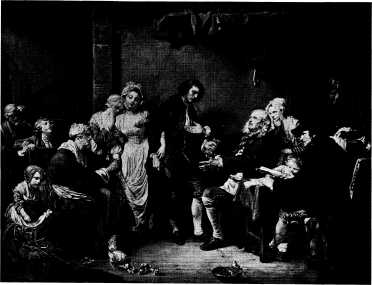
Greuze: The Village Bride, 1761. Paris, Louvre. In his Essay on Painting, Diderot objected to works such as these being
affected Greuze's artistic allegiances, for the author's critiques of the Salons are full of commendation for modern painters in whose work he discerns the Carracci, Domenichino or Le Sueur. He writes of Vien's St Denis preaching to the people of Paris: 'his painting is as wide in scope and as wise as that of Domenichino; handsome heads, correct drawing, beautiful hands and feet, fine draperies, simple and natural expressions . . . everything is effortlessly calm . . .'702 However, by the 1770s Greuze was not alone in his advocacy of Poussin's manner. The Abbe Laugier, who had played such an important role in establishing the theory of neoclassical architecture, declared in 1771 of Poussin: 'No hors d'oeuvre in his paintings, always the most advantageous point in the story, and the best circumstances to fortify the general expression; a laconicism
called 'genre scenes'. They were, he asserted, as much history paintings as Poussin's Seven Sacraments.
full of energy, which says much in a few words . . ,'699 If we lower the specification from ideal heroes to ordinary people at their moral best or worst, and from sentiment to sentimentality, the work of Greuze accords with this view of art. His paintings laid the foundations for further study of the seventeenth-century masters, and are actual prototypes for some of the compositions of J.-L. David. The converse is sometimes the case. Thus The Drunkard's Return of the early 1780s may well derive in figure scale, gestures and grouping from David's Belisarius of 1781 in Lille. But The Oath of the Horatii of 1758 by David takes its gestures and general approach from Greuze's earlier works. The two-way influence indicates both an attempt by the ageing Greuze to simplify and purify his style, and a similarity of aim.
207

LEFT Jacques-Louis David: Dead Marat, 1793. Brussels.
208
David: from Roman to Greek
When Vien returned in 1781 from a period as Director of the French School in Rome, he and his pupils represented, in the words of the Journal de Paris in 1783, 'the hopes of the French school of painting'. His school was to produce notable history paintings until after the Revolution. F. A. Vincent, who won the Grand Prix in 1768, was one of the first to treat French history in the grand manner; during the First Empire, he was painting contemporary scenes of historical importance, such as The Battle of the Pyramids. J.-B. Suvee studied under Vien in Rome, and won esteem for his religious paintings in imitation of Le Sueur as well as for ancient and modern history pieces. He was named Director of the French School in Rome in 1792. Another pupil of Vien, J. F. P. Peyron, won the Grand Prix in 1773 from under the nose of David with a Death of Seneca. He went to Rome to be groomed under the watchful eye of N. Halle, successor to Vien, and another history painter, only to have his fine Death of Alceste (Louvre) challenged at the 1785 Salon by David's Oath of the Horatii.
David was the most influential of Vien's pupils. He acknowledged his debt when, at the master's funeral in 1809, he lamented, 'Our father has ceased to live'. It was David who brought to fruition the years of planning at government level, although at first his ascendancy was by no means clear-cut.732 At first, he was no innovator in historical subject-matter, and he gained over his contemporaries because he was a better and more flexible artist. His biographer Delecluze wrote in 1855: 'He took up and followed four theories or, rather, four manners, characterised by the Horaces, the Marat, the Sabines and the Coronation of Napoleon.' His progression from Roman historical to Greek historical scenes and then to a Rubensian Baroque can be viewed as a response to changing circumstances social and political, if we take care to avoid seeing him as a politically subversive figure. The idea that his work of the Revolutionary period contains contemporary and subversive messages, rather than being generally appropriate to the mood of the Salons, does not bear examination.716'719 As a history painter, his interest is usually in the ideal, not in the particular. Even when he takes a contemporary event, as in the Dead Marat, he idealizes it, as we shall see.
David won the Prix de Rome in 1775. The work he was sending back to Paris showed that he was losing the decorative grace of the prize-work (Antiochus and Stratonice) in favour of the grim heroics of Homer728 and, in Michael Levey's characterization of Neoclassicism, of the triumph of the corpse in art (Rococo to Revolution, London, 1966, 167). His studies in Rome led him to Caravaggio735 and to his French equivalent, Le Valentin, one of whose works he is known to have copied.712 He made tracings of famous paintings,710 and built up a formidable collection of drawings. He most consistently imitated Poussin and the Car-racci.708 His St Roch interceding with the Virgin to Cure the Plague-stricken (1780, Marseilles) was painted in Rome, and clearly rehearses his studies of Italian art. The Belisarius begging for Alms, of the following year (Lille), signals the affirmation of Poussin's values for French Neoclassicism. Its restrained colouring, carefully studied antique architecture, majestically disposed figures and air of moralizing pathe-tique ensured its success. The Andromache mourning Hector, shown at the Salon of 1783 (Louvre) still shows the pathos of Greuze's The Son Punished. Four years later, greater praise was given to another conclamatio scene, Socrates taking the Hemlock (New York, Metropolitan), which Sir Joshua Reynolds hailed as the greatest step forward since the Sistine Ceiling and the Vatican stanze.736 This work replaces pathos with the stoicism of Poussin's Testament of Eudamidas. It is, much more than the Andromache, a philosophical and stoic theme which preoccupied the eighteenth century, inspired by the opening section of Plato's Phaedo731
We may consider the Socrates together with Brutus and his Dead Sons and The Oath of the Horatii, for all were considered important
209
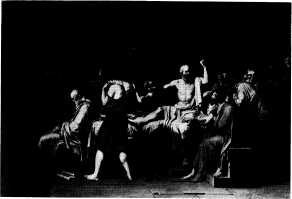
David: Socrates taking the Hemlock, 1787. New York, Metropolitan Museum of Art.
enough to be re-exhibited at the 1791 Salon. And in 1795, the Socrates was copied in an engraving by order of the Committee for Public Instruction, as an example of virtue. All three works represent a stern and stoic morality which holds the State in greater honour than family ties.711 In all three, the seventeenth-century foundations of this latter-day Corneille have been fortified by a new and terrifying realism, a function of the dramatic stage-lighting which has its origins in Caravaggio. The setting points both the action and the moral. The three arches in the Horatii form the composition and yet irrevocably divide the participants from the mourning onlookers. The torso of Socrates is silhouetted against the large contemplative area of the wall. The columns in the Brutus divide him and the Goddess Roma from the light, and emphasize his dark resolve and calm posture in contrast to the frozen panic of his weak womenfolk, who collapse in a fluttering heap like the slain daughters of Niobe. All three scenes take place on a narrow stage, the few figures in bas-relief pressed by the setting to the front plane. In all three David makes use of unyielding geometry to symbolize unyielding virtue. The theatricality of the three paintings is not incidental. The Brutus was inspired by
210
Voltaire's popular play of the same name (1730), and Voltaire, like the figure he portrayed, was a popular hero of the Revolution. The Oath of the Horatii was probably engendered by a visit to a production of Corneille's play Horace in 1782; after seeing this David sketched the scene where the father defends his son for having killed his (the son's) sister Camilla, who had thought fit to upbraid her brother for killing a Curiace whom she was to marry.709'718-730'737 D'Angivillier ordered a painting on this scene, for the King, which was to be shown at the Salon of 1783. David had second thoughts, and hit on a more heroic idea not in fact shown in Corneille's play: he imagines the sons swearing loyalty to the State on their swords, their poses repeating each other and reinforcing their mutual resolve. Their father holds up the swords, which cross at the vanishing point of the perspective. David thus invents an action which epitomizes heroism as enacted by ideal and unswerving actors. The rigour of his classical morality is not reduced by the knowledge that there is no antique source for the practice of swearing on swords, which is a feudal and Christian idea. All three paintings deal with eternally valid moral problems within a classical tradition of iconography and style. It is worth repeating that David can have had no subversive intention when he painted any of them.
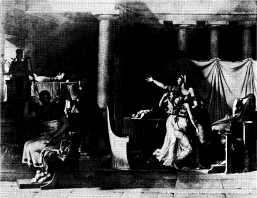
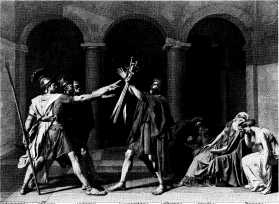
David: Brutus, 1789. Paris, Louvre.
David: The Oath of the Horatii, 1785. Paris, Louvre.
The important works which David executed during the Revolution also bear an antique, generalized and heroic interpretation. The Oath of the Tennis Court,721 the Dead Marat724
and the Lepeletier de Saint-Fargeau Assassinated734 show contemporaries and record important events, but do so through references to David's earlier works and to the classical tradition itself. The Oath of the Tennis Court reworks The Oath of the Horatii on a Baroque
211
scale, and the Lepeletier appears to have paraphrased the Andromache mourning Hector. The painting of this work was probably destroyed by a Royalist descendant in 1826; it is known through a drawing by Devosge, and an engraving by Tardieu. The reminiscences in the Marat are more diverse. It is a pagan pieta reminiscent of the work of Annibale Carracci, with the instruments of the Passion transformed into writing implements, and the lance-thrust into the actual wound which Marat received. But the inscription, the equivalent of the Christian INRI, translates the packing case (to represent Marat's simple way of life-compare Diogenes and his barrel) into a votive table in the antique manner. Marat suffers as Winckelmann thought Laocoon suffered, in noble silence. He is a political martyr, and the bath in which he worked because of a skin disease becomes in effect the parade bed on which his corpse was actually displayed for public veneration. Is there any sign of the gruesomeness of death or, indeed, of that skin disease? Patched sheets, a packing case, and a corpse in a bath full of water and blood are combined in a painting which owes its heroic idealism to the abstraction of the composition and to the Caravaggesque spot-lighting. These transmute sordid objects into shapes which have their own self-sufficient beauty. Thus the
packing-case is a utilitarian object, a firm counterpoise to the corpse, and also a grave stele; it controls the shape of the composition and is the key to its strength and to its meaning. Finally, to emphasize the universality of Marat's sacrifice, the scene is set without any distracting background, in what is perhaps a Revolutionary vision of heaven. The modernity of the Marat is deceptive; although David certainly saw the actual corpse in situ, and may have used wax models in the preparation of his painting,720 he imitated the famous antique relief of The Bed of Policletus, which he would have known from the replica in the Palazzo Mattei in Rome. The comparison is exact, the source common, for it had been known to Ghiberti, and probably suggested to Michelangelo the pose for the Christ in the St Peter's Pieta.
That incitement to virtue which is the aim of history painting, and which was one reason for the setting up of museums throughout France,706 was emphasized by David's stage-management of festivals in the antique manner during the Revolutionary period.713"15 These were intended to epitomize the aims and ethos of the national purpose through sanctification of its ideals. The means used were processions, tableaux vivants, or paintings and statues to which the public did honour. The enactment
The Bed of Policletus, antique relief. Rome, Palazzo Mattei.
212
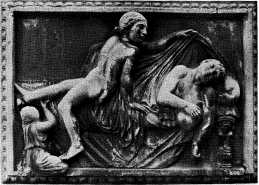
of Roman festival structures adapted to the glorification of a modern regime was, of course, a procedure much used since the Renaissance. But never before had prominence been given to the Roman Republic (instead of the Empire) via the images of its most famous heroes, and to their modern descendants who, by continuity and by iconography, were compared with their prototypes.707'725 Thus Lepeletier de Saint-Fargeau, stabbed to death on 20 January 1793 by a Royalist for voting in favour of the King's execution, was exhibited in public on an antique couch, the drapes pulled back to reveal his Christ-like wound, and his clothes and the sword with which he had been killed prominently displayed. Candelabra and tripods decorated the high podium, to be mounted by the President of the Convention when he crowned the dead hero with a laurel wreath. At David's request, a bust of Lepeletier was placed next to that of Brutus in the Convention; when Marat was killed on 13 July 1793, his bust quickly joined them. On 16 October 1793, David's painting of Marat was first shown to the public (it had been ordered by the Convention) in the courtyard of the Louvre, together with that of Lepeletier. Each stood on an antique sarcophagus, and they made, quite deliberately, a matching pair. An earlier ceremony which David might have managed probably affected the form and public presentation of these two works. On 11 July 1791, thirteen years after his death, Voltaire's body was brought to Paris and conveyed to the recently finished Pantheon (originally St-Gen-evieve), which was decreed as a hall of French fame in the antique manner.727 The writer-philosopher's remains were transported on an imitation antique chariot, inside a mock-marble sarcophagus flanked by genii with upturned torches. On top, on an antique bed, lay the effigy, chest exposed, and about to be crowned with a laurel wreath by a Victory. Incense smoked from candelabra at the four corners of the carriage. Participants in the procession were naturally in Roman dress, to add authenticity to the occasion/The hero's apotheosis was an antique idea which David would have^known from his studies amongst the monuments of Rome and in the books of Bartoli and Montfaucon. With such festivals in mind, we can appreciate the associations touched off by the paintings of Marat and Lepeletier. They represent not the triumph of the corpse in art, but rather the apotheosis of the hero through death into a god.
The year 1793 saw the culmination of David's ideas on the privileges and unfairness of the Academy. The body had debated, in 1790, and amidst much opposition, a democratization of organization. In 1791, the Salon had been opened to all comers. Following a report from David, 1793 saw the suppression of all academies, and the Salon that year was, strictly speaking, organized by the 'General Commune'. It contained several works of contemporary history. In October of that year, the Convention instituted a prize for painting and sculpture. In that first year, the set subject was, for painting, Brutus killed in Combat and carried Home by his Peers, and for sculpture, The Schoolmaster of Falerii (a subject painted by Poussin). The entry by Harriet, a pupil of David, provoked a remark by one juror which captured the true role of Antiquity in painting at that time: In two years there will be born a sublimity which will surpass everything which we admire—sometimes with prejudice—in the antique. We will not be Athenians nor Romans, slaves who carry the name of free men, but Frenchmen, free by nature, philosophical by character, virtuous by disposition and artists by taste.726
Sentiments such as these were reinforced in 1794 by a proclamation urging artists to depict the famous scenes of the Revolution, or to design statues to be erected in honour of modern great events. In effect, David's complaint against the Academy was one of unfairness, but he did little to change its basic role; from its re-institution in 1816 (after a period as one section of the Institut), it flourished.
Like that of many fellow artists, David's style changed during the last years of the century from a Roman style summarized by the Horatii to a less realistic, almost abstract style based on line. This attempt to purify his work, perhaps spurred on by his respect for Giotto
213
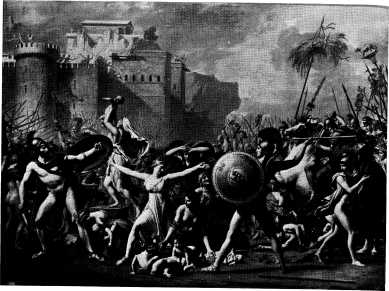
David: The intervention of the Sabine Women, 1799.
and certainly by the currents of primitivism already discussed, formed a Greek manner best seen in The Intervention of the Sabine Women of 1799 (Louvre). David turned to the newly popular study of Etruscan vases,717 the only Greek paintings extant, and Flaxman's demonstrations of how they might be adapted to form a new linear style which would suit primitive subject-matter such as that of Homer.733 No matter how frieze-like neoclassical multi-figure compositions had hitherto been, none had been denied that combination of light and texture which gave objects physical and moral weight and a definite position in space. But now, in search of a purity which they associated with the very earliest stages of art, artists sometimes threw overboard the accumulated technical expertise of art from the High Renaissance onwards.729 The resultant outline style could never gain exclusive support from any artist, for its suitability for the decorative arts and for drawings and engrav-
214
ings was matched by a patent unsuitability for large commissions. David's Sabines, partly based on Flaxman's Diomedes casting his Spear against Mars, is, however, not wholeheartedly primitive. Its composition, expressions and attitudes owe much to the Renaissance tradition of battle and catastrophe scenes; its fresco-like tones, exactitude of draughtsmanship and archaeological detail smack of the Academy.722 One modern critic has referred to the 'deliberate self-sterilization' of works like this, and their 'reaction against the committed "Gallic" forms of his Revolutionary works'.723 Certainly, the works in this manner which David was to paint in the years left to him— e.g. Sappho, Phaon and Amor (1809, Hermitage), Leonidas at Thermopylae (1814, Louvre) and Mars disarmed . . . (1824, Brussels)—are not only deficient in moral energy, but might be said to smell of the lamp of industry rather than the light of imagination. They lack the humanity so conspicuously present in portraits in the same style, such as the Madame Recamier or the Madame de Verninac.
David's paintings of Napoleonic subjects portray themes which replace the stoic morality of his Revolutionary works with imperial Roman grandeur. Napoleon seemed the only man capable of saving France, and David was only the most prominent of several who aided his propaganda as he became general, then First Consul, and finally Emperor. If the style David created for this 'spirit of the age on horseback' had little to do with austerity and sacrifice, it is nevertheless important for the classical tradition because it drew explicit parallels with Antiquity, and still promoted a concept of art as a glorification of the State. Yet the ambivalence of the Napoleonic style must be emphasized. That style sowed many seeds which, when they came to fruition, were to undermine the whole notion of the classical tradition. As we shall see, any student of Romanticism or Realism in France would be forced to begin with David.
Neoclassical sculpture: Canova
Apart from some rather Baroque sketches, no such ambivalence between classicism and primitivism is detectable in the productions of Canova (1757-1822, roughly contemporary with David), the man who fixed the ideal style in sculpture for several generations. Because of the highly polished purity of his marble forms, and their evident and intentional connections with the masterpieces of Antiquity, Canova has received a bad press from modern critics who prefer the sketch to the finished work, and who condemn imitation as necessarily servile and as the enemy of spontaneity.* During his lifetime, however, and well after his death in 1822, his supreme excellence was not questioned. The success of his style entailed its spread throughout Europe in the form of originals, copies by his assistants, and engravings which he himself commissioned. As the
*'This is Canova's secret, to be cold and bombastic at the same time... preserved in the deep-freeze, stiffened by rheumatism, fossilised like anthracite. Form, in Canova, becomes ritual. . . he does not recreate, he imitates . -. .' (Mario Praz)744
one man who produced sculpture in accordance with Winckelmann's dreams, his work was an example to all. In his address to the Royal Academy on the sculptor's death, Flax-man remarked that 'prints of... all [his works] may be seen in the collections of the metropolis'.
Canova settled in Rome in 1780, leaving his native Possagno, near Venice, with its Venetian traditions, determined to study the antique thoroughly. His link with Winckelmann was through the productions of Bartolommeo Cavaceppi, the well-known restorer.741"3 His reputation was established by his Tomb of Clement XIV of 1783-7 in SS. Apostoli, Rome. Here, Canova chastens the Baroque formula represented by works such as Bernini's Tomb of Urban VIII in St Peter's, replacing Bernini's lush allegories by figures in noble, body-clinging draperies (much admired by David),739 their restraint and pose reinforcing the cubic severity of the whole composition. A source for Canova's tomb type could be sarcophagus
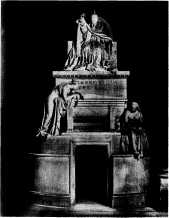
Antonio Canova: Monument to Pope Clement XIV, 1783-7. Rome, Chiesa del SS. Apostoli.
215
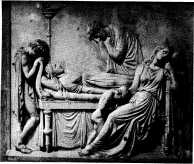
Canova: 'Conclamatio' relief: Monument to the Countess of Haro, c. 1806, Possagno.
reliefs of The Death of Meleager, in which similarly disconsolate figures are placed in profile or full-face. He uses the same format and motifs for his Monument to the Countess of Haro (1806, Possagno), and subsequently adapts the mourning figure in profile— standing, leaning or reclining—for a series of monuments based on the form of the Greek stele. Another basic shape, the pyramid, governs the structure of his internationally acclaimed Monument to the Archduchess Christina of Austria (1805, Vienna, Augustines). Virtue carries the ashes of the Archduchess into the tomb in much the same way as Benjamin West's Agrippina carries the ashes of her husband Germanicus in the painting of 1768, now in Burghley House, Northamptonshire. The variety of Canova's monuments large and small, usually of bas-relief format, quickly made them popular. They combined the purity of white marble and the simplicity of voguish antique references and forms with a softness of execution and a sentimentality which evoke the work of Greuze or Vien.
It is his mythological and mytho-portrait pieces which approach the ideal of Winckel-mann. Cicognara tells how, when the young Canova had finished the naturalistic Daedalus and Icarus, Volpato, Pompeo Battoni and Gavin Hamilton admired it. Hamilton urged him 'to unite with so exact and beautiful an imitation
216
of nature, the fine taste and beau ideal of the ancients, of which Rome contained so many models, predicting at the same time, that by such a course he would greatly pass the limits which had been reached by the moderns'. In Canova's mature works the references are always clear, and herein lies their success. Their sensuality is often heightened, both by the working of the marble (perhaps the influence of his Venetian training) and by the sure sense of line and silhouette. Except in the case of a few works like the Hercules and Lichas where the Farnese Hercules moves like Laoc-oon, Canova's productions are of a crystalline delicacy. Nearly all the figures, except those representing moderns in antique disguise, are in heroic nudity, and display Canova's knowledge of formalized anatomy without trying to describe the human body realistically. He was not trying to make his figures look alive. A visitor to his studio, one of the sights of Rome, thought to praise him by remarking that the Hebe looked as though she might fly. Canova is said to have replied: 'I do not aim in my works at deceiving the beholder; we known that they are marble—mute and immobile ... If my work were indeed taken for the reality, it would no longer be admired as a work of art ... I would [i.e. wish to] excite the fancy only, not deceive the eye . . .' Certainly, part of the charm of the Hebe of 1795-8 (examples Chats-worth and Berlin) is precisely in an elaboration of undulating lines which abstract the forms and therefore negate realism, helped by the unnatural whiteness of the marble. Canova's movement toward abstraction, so characteristic of the age, is shown by the ease with which his works translate into outline engraving without losing all effect. (Nevertheless, his subtlety of construction allows his sculptures to give a pleasing silhouette from several different viewpoints.) Similarly, his interest in two-dimensionality is underlined by a series of projects for bas-reliefs on Homeric and Stoic themes designed between 1789 and 1794. These designs, of subjects like The Death of Priam, Socrates taking the Hemlock and Tele-machus returning to Ithaca, are so chaste that they resemble outline engravings. Only the scene of Socrates taking leave of his Family reached marble, and that remained in his Studio. They were all, however, widely known through engravings.
Canova's popularity generated commissions from Napoleon and his family, in most of which he sought to portray the dynasty as successors to their imagined Roman imperial forebears.745'747 In 1798, Rome itself was again a republic with a tribunate, a senate and five consuls. In 1809 it was annexed to the French Empire. References made by artists to the antique were therefore reasonable as well as fashionable. In 1807 Canova made a larger-than-life equestrian statue of Napoleon, in Roman dress, but the Emperor's fading fortunes ensured that he was soon, as it were, unhorsed, and the horse, in the Piazza del Plebiscito in Naples, now bears the figure of Charles III of Naples. In the colossal statue now rather appropriately at Apsley House, the Emperor is seen in heroic nudity. Letizia Bonaparte appears as Agrippina Seated (1805-8, Chats worth) and, most famous of all, Pauline Bonaparte is shown as Venus7'10 (1808, Villa Borghese, Rome). A comparison of this cool yet voluptuous work with Ingres's La Grande Odalisque of six years later shows the wide range of sexuality which an outline style can express. Ingres knew the Venus, but the origins of both works must be something like the antique Sleeping Hermaphrodite in the Museo delle Terme, a type which inspired Canova's Reclining Fountain Nymph (collection of H.M. Queen) as well.
The greatest following of Canova's style was in France, and it was often interpreted by resident foreign artists. During both Consulate and Empire, artists flocked to Paris to complete the plentiful commissions—another example of the internationalism of Neoclassicism. In one sense, Canova's own style was partly formed from French ideas, since it was his friendship with the eminent antiquarian Quatremere de Quincy, and their exchange of letters over many years, which fed him with a programme of classical aesthetics. Quatremere also made suggestions for subjects (such as the equestrian statue of Napoleon), and gave approval and encouragement. Thus, when Canova tried tinting some of his statues according to antique
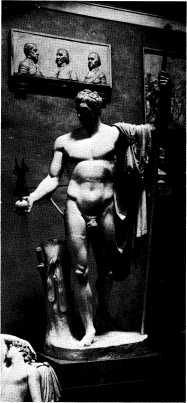
Canova: Modellofor the colossal statue of Napoleon, seen in the artist's museum at Possagno.
practice as suggested by Quatremere's researches, the Frenchman had to soothe him in the face of the predictable public reaction.748 Whiteness was generally equated with purity—as with the popular misconception today about the whiteness of Greek temples
217
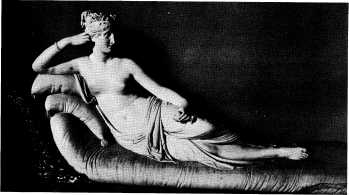
Canova: Pauline Borghese, 1808. Rome, Villa Borghese.
(which were in fact painted). The horror of the early nineteenth-century aesthetes when Quatremere pointed out that Greek temples were brightly coloured, and antique marbles sometimes treated in the same manner, might be comic to us. But the shock is characteristically that of the warm wind of an imagined ideal meeting the cold wind of reality which could not match up to the dreams.
Canova went to France three times, first in 1802, when he met David, then in 1810, and again in 1815. On the first two occasions the purpose was to execute portraits of Napoleon and his family; he even resisted an invitation to settle in France and become Director of Museums. On the last occasion he came to supplicate the Allies for the return to Italy of the works of art stolen by Napoleon, another cause dear to the heart of Quatremere. Among French sculptors, Canova was very influential: Chaudet's soft and feminine style found echoes in Canova's forms, and imitated them: he was in Rome in 1781-9. Joseph Chinard, in Rome 1784-7, worked in a similar style. Even some painters, particularly Girodet, Gerard and Guerin, took inspiration from his delicately linear representation of the nude. In more general terms Canova's achievement was to remain the ideal for academic sculptors for the
218
whole of the nineteenth century. He worked in enough genres to provide a wide variety of imitable forms. His outline style, superficially simple, pure without austerity, graceful without over-distracting voluptuousness, antique without dryness, was repeated all over Europe and America, with an intensification of those features of hardness and dryness which were all too evident in the studio repetitions and other copies of his art.
Canova's works were also very popular with the English,738-750 as the large number of them in English collections testifies, and as his influence on Flaxman or, at least, the similarity of their styles, suggests. Flaxman studied Greek vases as a young man, but his style only came to maturity during his stay in Italy in 1787-94, where he studied Italian art before Raphael.751 His appreciation of Canova (who obtained at least one commission for him) is reflected in his Fury of Athamas of 1790-^4 at Ickworth, Suffolk, a comparison of which with Canova's Hercules and Lichas gives some indication of comparative quality. Canova maintains the vigour of his sources in an original composition; Flaxman freezes his passionless forms into a parallelogram of ice. Canova works on the marble himself; Flaxman makes a small model which assistants then enlarge.

Ingres: La Grande Odalisque, 1814. Paris, Louvre.
Flaxman tries hard to adapt a neoclassical style to modern dress; this, and realistic features of any kind, Canova avoids. The results of Flaxman's efforts are to be seen in his large, if not great, monuments to Nelson and other heroes of the Napoleonic Wars in St Paul's, London, England's Pantheon. Other members of the aptly named Peninsular School to get commissions there were Westmacott (a Canova pupil), the aged Thomas Banks and the young Francis Chantrey. Here, allegories in antique drapes are juxtaposed with glassy-eyed heroes in contemporary dress; fine poses are rendered ridiculous by weak composition and wooden execution.
The advent of the Elgin Marbles746'749 in 1806 should, perhaps, have prevented St Paul's from becoming the graveyard of English sculpture, but it did not. Indeed, the evidence given to the Select Committee which was set up in 1816 to deliberate on whether the Marbles should be bought for the nation made it clear that, although they were much admired, they by no means overshadowed the other antiques which had been famous since the Renaissance. The famous occasion when Richard Payne Knight of the Society of Dilettantes shouted at Elgin that his Marbles were of the time of Hadrian emphatically does not prove him a
fool, for the Elgin Marbles were outside any accepted eighteenth-century view of the ideal.752 Would they have caused a revolution in art had they been imported fifty years earlier? B. R. Hay don's pathetic attempts to raise a British school of history painting by imitating them find no echo in sculpture itself. Westmacott's admiration for them did not radically affect his art, nor that of his successors. Canova himself came to see them in 1815 and, as he wrote to Quatremere the same year, quickly realized that most of the works on which he had based his style had been copies. He characterized the copies as affected, exaggerated, hard, conventional and geometrical in comparison with the 'real flesh, the beautiful nature' of Phidias' creations. But he had only seven years left to live, and the work he had in hand for which models had already been made, together with his advanced age, prevented any change in the direction of his work.
The relative fidelity of sculpture to the classical tradition during the nineteenth century is a reflection of the difficulties of introducing elements of modern reality into a classical form without producing bathos. The dearth of high-quality sculpture in the classical manner after Canova's death may result
219
partly from the legacy of Winckelmann's theories and of the antiques over which he enthused. These certainly deadened more talents than they inspired, since imitation soon became mechanical. Sculpture, the medium in which the earliest advances of the Florentine Renaissance had been made, the medium which had set the standard for the representation of the human form in paint, feeding the painter in his constant search for solid and convincing models, was about to be left behind by painting. The more adventurous the styles of painting became, the more retardataire classicizing sculpture looked by comparison. As painting style became less sculptural, so the sculpture became more painterly. The great sculptors of the nineteenth century, such as Gericault, Degas, Daumier and Rodin, were also painters. None is classical in any sense acceptable to Winckelmann. Their preoccupations are with modernity.
Painting in Napoleonic and Restoration France: classicism and modernity
Problems of modernity and realism occupied French artists during the Napoleonic and Restoration periods, even when their work was superficially classical. Hinted at in the work of David, these problems became explicit in Gros and Gericault, and contrast somewhat with the antiquarian aspirations and splendour of Paris as a consular and then an imperial capital second only to Rome, which was in French hands from 1809 to 1814.755'770 Napoleon was, reportedly, no judge of art, but he saw how the arts could help his political advancement. Helped by advisers, particularly Vivant De-non,756'765 he commissioned painters to depict his battles and noble deeds, supposedly with the example of Poussin in mind. He reputedly took an engraving of Poussin's Testament of Eudamidas with him on his Egyptian Campaign, remarking at one point to Denon, 'After one has seen this austere composition, one cannot forget it; Denon, our school of painting has grown stale; we must being it back to the ways of Poussin . . ,'773
The planning of Paris after the Revolution,
220
the education of artists and the glorification of the ruler were all carried out on a grandiose scale.754 Paris cast off its medieval air (a process suggested by the architect Pierre Patte in 1764 and partly begun in the seventeenth century) as its streets were punctuated by fine squares and triumphal arches, and churches and public buildings were erected in a classical style. Sculptors were encouraged to show parallels between Napoleon and antique rulers, and the great man's progress was monitored on medals, just as Louis XIV's had been.768 Furthermore, a conscientious Emperor must be a connoisseur: Napoleon enriched Paris with spoils from his conquest of the whole continent. When, for example, on 27 July 1798, works of art from Rome, central Italy and Venice reached the capital, they were paraded through the streets as in an antique triumph,756 like Sulla's trophies from the sack of Athens, or Constantine's vaunting of the treasure from Jerusalem. Most of the works of art were in packing-cases, but the bronze horses from St Mark's, Venice, were on view: a palpable reminder of Constantinople whence the Venetians had taken them. One aim of the looting was to increase the number of examples for artists to study, and that aim was pursued with native French examples as well when the Musee des Monuments Francais was opened in 1795. Ecclesiastical properties had come into state ownership in 1789, and the museum received from churches and monasteries sculpture and works of art dating from the Middle Ages to the eighteenth century. Paintings from the same sources went to swell the old Royal Collections and formed the National Museum of the Louvre, which opened on 10 August 1793.759 The Musee des Monuments Francais was open on three days out of every ten for the general public, and on the other seven for artists alone.
The didactic aim of the Musee des Monuments Francais, and the political tint of that didacticism, were seen on the first page of the catalogue: 'Cultivation of the arts enlarges a people's commerce and prosperity, purifies its morals, makes it more gentle and more ready to follow the laws by which it is governed The earlier ages of art were included largely as an object-lesson in what to avoid. The Direc-
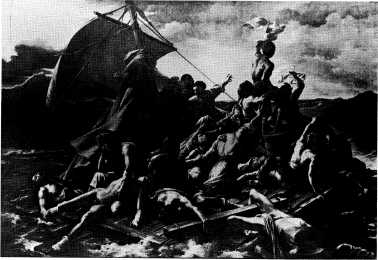
Gericault: Raft of the Medusa, 1819. Paris, Louvre.
tor, Alexandre Lenoir, explained that the subdued level of fighting in the medieval section represented the level of culture when 'our school of art was sunk in the most frightful barbarity'; it was intended to convey 'that magic by which beings filled with superstitious fear were held perpetually in a state of weakness
Yet whatever the original intention of this museum, it is clear that confrontation with their medieval heritage inspired rather than revolted French artists. Among the paintings, the stylistic range of the looted works of art was similarly wide, from Raphael to Rubens, from the Italian primitives and Jan van Eyck to Tintoretto and Dutch landscape. Perhaps David's huge canvases on Napoleonic themes reflect some enthusiasm for the Baroque works on show—and an awareness that the numen of Napoleon could not be depicted within the strict neoclassical formula of The Oath of the Horatii. We might, indeed, see in Delecluze's dictum of the four manners of David (the Horatii, the Marat, the Sabines and the Coronation of Napoleon) a way of clarifying the undoubted stylistic confusion of the whole Napoleonic period. The vogue for death and suffering, for strange and minutely detailed settings, for deep shadow,735'760 for the imagination rather than the reason—all these can be traced in David, but usually restrained by the simplicity of his compositions and the light of his reason. Thus a comparison between Gericault's Raft of the Medusa of 1819 (Louvre) and David's Brutus shows many points of similarity. The divergence is in intention: between the anecdotal horror of suffering innocents cast adrift on the sea of life, and the self-willed sacrifice of family needs to the good of the State; between a group of people to whom things just happen and a man who controls his own fate. Leaving aside problems of Gericault's political awareness in the choice of that theme, and his undoubted attempt to make a serious humanitarian point, we may focus on his fascination with the macabre and perhaps judge that it perverts the monumental aspirations of that gigantic work.764 Gericault's
221
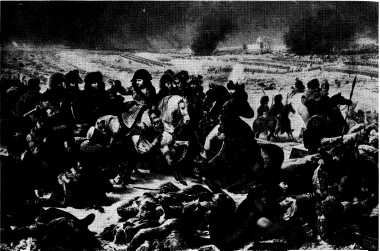
Gros: Napoleon on the Battlefield of Eylau, 1808. Paris, Louvre.
works, whatever their sources and however apparently classical their compositions (for example, his riderless horse-race scenes), possess an animal power which, together with his interest in abnormal physical and psychological states, removes them from the sphere of the rational, and reflects several of the preoccupations of Romanticism, signs of which are discernible in French painting long before Delacroix.757'772
Ambivalence is also a characteristic of the work of Gros, a pupil of David. In spite of his avowed position as upholder of his master's classical style,766 his depictions of Napoleonic battles and other propaganda scenes did not permit a totally idealistic rendering.767 Or, rather, Gros sought to mix the traditions of a Lebrun (who painted many battle-scenes for Louis XIV) with real-life scenes of the horrors of war which he himself witnessed as an artist commissioned to follow the army. Unlike Leonidas at Thermopylae, Napoleon's armies did not fight in heroic nudity under a Greek sky. Gros therefore attempted to balance the ideal hero761 of his antique bas-relief settings769
222
with a decided appetite for horror. Clearly, Gros needed the stimulus of real events775 to fire his imagination. Unfortunately, his professorship at the Ecole des Beaux-Arts from 1816 entrenched the drier side of his classicism, as shown in his decorations for the cupola of St-Genevieve of 1814—24, with Louis XVIII quickly substituted for the intended Napoleon. These earned him a baronetcy from Charles X—an indication of official acclaim— and the telling comment of Gerard that Vest plus Gros que nature'. He was referring to the work's inflated rhetoric and to the significant lack of those qualities of reportage which had brought his otherwise highly stylized battle scenes to brilliant life. Gros's style remained stiff, and the poor reception of his Ads and Galatea and Hercules and Diomedes at the 1835 Salon probably caused him to commit suicide. How much of the change of style during the first decades of the century was due to official pressure? We know that Napoleon, perhaps taking his cue from Denon, hated allegories. He is reported, in front of David's Sabines, to have said that he had never seen his own soldiers fight like David's, and then offered to take David on campaign to see some action. Denon himself, in 1805, declared that his intention was 'to turn the arts particularly toward subjects which would tend to perpetuate the memory of what has happened these last fifteen years', and he set about achieving that aim by bureaucratic means.765
Even more indicative of the ambivalence of styles during this period is the career of Girodet.753'771 He was much acclaimed by Gros, and when he died in 1824 it was the funeral discourse pronounced by Gros which predicted 'the imminent collapse of painting and sculpture, if students did not choose as models, from among the torrents of painting drowning the Salon, the works of David and Girodet'. If we bear in mind the admiration of Delacroix and Gericault for the work of Gros, then Girodet's The Funeral of Atala or Endymion Asleep (1808 and 1790/1 respectively, both Louvre) seem too delicate, sensuous and sentimental to please the classicists and insufficiently robust for the romantics.776 Girodet's work is classical in form, but romantic in atmosphere, sentiment and subject-matter ; although he wrote from Italy in 1790 to his friend Gerard that he was more impressed by Rubens's Medici Gallery than by any painting in Italy, his works are almost transpositions of Canova into paint. In 1791 he asked Gerard to send him Rollin's Histoire Romaine, Plutarch, his print of Poussin's Pyrrhus, two landscapes by Poussin, 'and my Etruscan objects'.758
The cracks in the facade of classicism became explicit after the fall of Napoleon and the withdrawal of David to exile in Brussels (Rome was refused him). David's politics made him persona non grata, and his paintings were reviled by critics who saw them as stiff, academic and lifeless. A classicist was, for Delecluze in 1827, someone who 'worked mechanically from antique statues'. David himself, commenting on the Salon of 1808, had predicted the course that painting would take: 'in ten years all study of the antique will be abandoned ... all those gods and heroes will be replaced by knights and troubadours singing underneath their lady's window at the foot of some old castle'. Certainly, the restored monarchy had some taste for the antique, but French history and scenes of modern life came strongly into favour. The great Napoleonic history pieces were, needless to say, hidden. Paintings of subjects from the antique dropped steadily in number until 1827, and then much more sharply during the reign of Charles X (1824^30), who preferred modern subjects. Jon Whiteley, in a thesis which documents the fortunes of antique subject-matter in France at this time,805 has pointed out that antique themes declined not because of the rise of Romanticism (cf. Delacroix's remark that David was 'the father of the modern school') but because David's own pupils, ensconced in positions of power in the Institut, had abandoned them. Official commissions, however, with their emphasis on classicism, continued to be as important as ever for an artist's livelihood. The journalist Auguste Jal reminded his readers in 1828: 'The Salon is as political as the elections . . . the wishes of Church and Government can be clearly seen in a dozen paintings and statues . . .; artists are independent, but all hope for work from Government or Prefecture.'762 Under Charles X it was the Ministry of the Interior which dealt with orders for church work, and the Direction des Musees Royaux which selected works from the Salons for distribution to the provinces; this was a policy of centralization which was to kill off provincial schools of art and, by the examples the Direction sent, to set the standards for public decorative commissions for the rest of the century.
Government policy towards art, and an assessment of the state of the market, was set out in an internal memo of 1816,763 which deplored the recourse of painters to contemporary history showing people in contemporary dress: '. . . the coming generation has, indeed, become discouraged and abandoned the historical manner, the sole one worthy of the protection of the Government, and given itself almost exclusively to the anecdotal manner . . . [Contemporary dress] does not allow the painter to develop the grand principles of art ... the study of design is neglected . . .'
223
The document went on to say that genre painting, which did not have the moral bias of history painting, must be discouraged by making sure that students who won the Prix de Rome should receive commissions for history paintings, and those who did not win the prize should nevertheless have the chance to do something for the Government, for, 'having no renown, [such artists] will have no pretensions, and whatever price is paid for their work will be regarded by them as fair
Ludovic Vitet saw the relationship between classicism and the government as a vicious circle and described it in an article written in 1825 entitled 'On independence in matters of taste: the intervention of the Government':
The coalition of classicism and power is in no sense a chimaera, for the one puts into practice what the other has preached in theory. The one says: Only those who follow my lessons have good taste. And the other: Only those whom I authorise have talent. From both sides, it is an apology for monopoly . . . Our statesmen are, basically, neither classic nor romantic . . . but they have such sympathy with routine and immobility that it seemed totally natural to them to organise the fine arts exactly as they were before the Revolution . . ,778
Not that the pensionnaires at the French School in Rome were as pliant as the Government might have thought. During the Directorship of Guerin (a staunch classicist) between 1823 and 1828, the students gave him a difficult time. One reason for their objections must have been the severe classical line which Guerin, under the inspiration of Quatremere de Quincy, tried to adopt. Quatremere was one of the most powerful men in the artistic world. Appointed Perpetual Secretary to the Academy of Fine Arts on its reconstitution in 1816, his position assured him of power over policy, as almost twenty-three years of correspondence demonstrate. For example, he wrote to Guerin in 1823: 'It is evident that when the King keeps students ... it is with a view to training them to serve the government . . . ancient Rome and, above all, modern Rome, offer many examples of monuments suited to French usage.'691 He was referring to students of architecture who were, of course, even more reliant on official favour.
Our perspective on nineteenth-century art, and our estimation of who was or was not a good artist, is radically different from that of Quatremere. Modern opinion sees artistic 'progress' at that time as in the hands of the rebels, those men who were anti-Establishment because their work was rejected, anti-museum because the museums perpetuated 'good' art, and anti-Salon because the Salons were rigged by official taste.774 From such an ahistorical perspective, it is all too easy for the modern critic to see works like Delacroix's romantic nightmare, The Death of Sardanapalus,777 as an example of a new and vigorous style in the face of an effete classicism. Yet Delacroix's position was not so clear-cut. He was wounded by the scorn cast on the Sardanapalus, which is a history painting in the grand manner, with numerous antique and Davidian references. (He might have been partly inspired by David's Funeral of Patroclus, now in Dublin.) Although we must separate his theory from his practice, as in the case of Sir Joshua Reynolds, the fact remains that he admired Raphael as the greatest of all artists (and wrote an essay on him), revered Mozart, and detested Berlioz and, later, Wagner. He saw North Africa as the nearest society corresponding to that admired by Homer—Man in a state of nobility and nature—and painted as many works on antique themes as his rival Ingres. He stands with his great contemporary as a symbol of the confusion in the French art world in the first half of the nineteenth century.
224




















